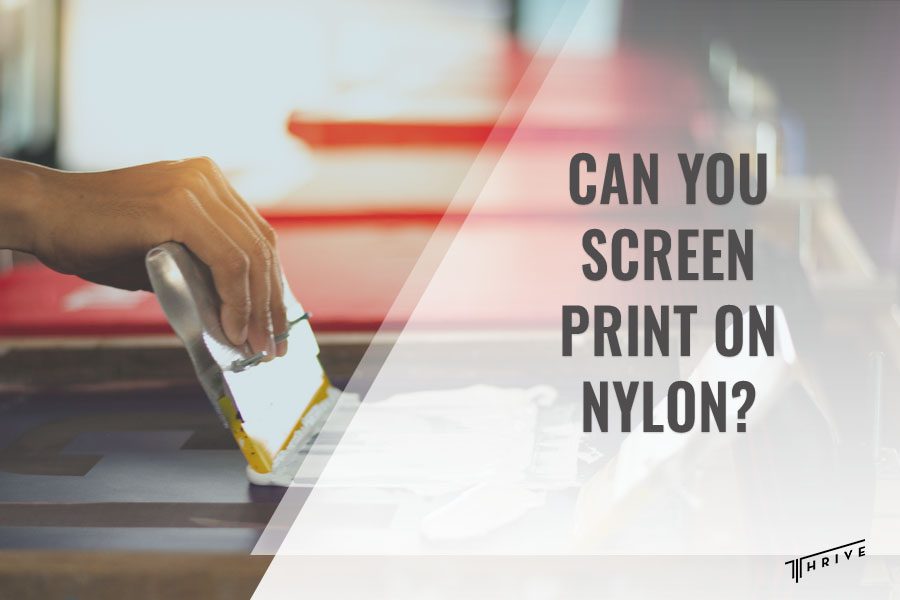
Screen printing on nylon presents unique challenges and limitations due to the material’s specific properties. Since screen printing methods are tailored to more porous surfaces, adapting the method to nylon requires careful attention and consideration. So, can you screen print on nylon?
In this article, we’ll explore the challenges of screen printing on nylon and how to overcome the complications. Discover the various types of nylon weaves and how they affect the print. You’ll also discover the equipment needed for screen printing on nylon and explore the various alternative methods to achieve top-notch prints.
Can You Screen Print on Nylon?
Screen printing refers to the process of transferring a stenciled design onto a flat surface using ink, a squeegee, and a mesh screen. This technique is relatively popular and used in various printing industries to create stunning designs on numerous printing materials. While fabric and paper are the most commonly screen-printed surfaces, specialized inks also allow the possibility to print onto wood, metal, plastic, and even glass.
However, nylon has represented a challenge for many printing industries due to its specific characteristics. But a contract screen printer for nylon can help you achieve top-notch designs on any material, even nylon! With our dedicated team and the latest equipment to design, nylon is the perfect surface for crisp and clear prints that our customers love.
Types of Nylon Weaves
Before we continue with the process, it’s essential you understand the different types of nylon weaves we can get your design on. As with other materials, nylon comes in a myriad of weaves, which have different purposes associated with different challenges when screen printing.
Some of the most common nylon weaves include:
- Taffeta – This material is a basic weave of nylon fibers, which are alternately woven together in a lattice formation. Since this material is a dense and tight weave, its surface is stable and smooth. This allows precise screen prints and designs. This weave is popularly used for lined and unlined jackets, banners, windsocks, umbrellas, and lightweight tote bags.
- Satin – Satin is widely known for its glossy feel and luxurious look. This nylon weave is often used to create jackets, but it’s occasionally used for other substrates. Due to its delicacy and smooth surface, you can apply various prints and designs.
- Oxford – This nylon type is a heavy basket weave often used to create a rough texture for athletic jackets, tote bags, luggage, banners, and flags. While its rough surface may require a thicker layer of ink for an even print, it’s nothing our team can’t handle.
Nylon vs Other Fabric Printing — Differences
So, why is screen printing on nylon so difficult? Screen printing on nylon is drastically different from printing on any other fabric. This is due to the material’s characteristics. While nylon is considered a durable and strong material, it may pose several issues for every screen printer.
Nylon fabric has a smooth but slippery surface, which presents a challenge when trying to hold it down. Without special equipment to secure the material, the designs may come out uneven, with jagged ends, or wrinkled.
Furthermore, another problem printers face with nylon material is its ink absorption. This material can’t absorb ink that easily, which may result in poor-quality color formation. Regular ink will sit on top of the nylon when printed at low temperatures instead of bonding with the fabric. Since high temperatures may shrink or even melt nylon, we use specialized inks to create crisp and clear designs on this material.
So, with proper equipment and toolsets, you can print any type of design on nylon. Keep in mind that you’d need to refrain from ironing or washing your nylon products at high temperatures, which makes the prints last up to several years.
Tools for screen printing on nylon
Along with the common equipment for screen printing, there are several additional items that help us create clear printing designs on nylon. This includes:
- Specialty ink or nylon catalyst – It’s crucial to use accurate inks for printing nylon, as regular plastisol ink requires high temperatures that can melt nylon. Instead, heat-cured inks or sublimation inks are great alternatives and suitable inks for nylon prints. The heat-cured inks are printed onto the nylon fabric then a heat press is used to activate the ink.
- Jacket hold-down – Nylon’s smooth finish may cause some difficulties for the material to stay in place. This is true, especially if the nylon material has a liner. The shell will shift over the liner during printing. The solution for this issue is a jacket hold-down that will hold the nylon in place throughout the screen printing process. It surrounds the substrate on the platen, prevents any shifting, holds the material securely, and resolves any wrinkles.
- A sharp squeegee – A nylon printing demands the use of a sharp, hard squeegee with a straight edge. For the best outcomes, we use a 70 or 80 single durometer squeegee, but using a 60/90/60 or 70/90/70 triple-durometer squeegee is also a great option.
Different Printing Methods for Nylon Fabric
In screen printing, there are several printing methods used for nylon printing that deliver different results. We have pulled together some of the most commonly used methods and explained them below.
Cold transfer printing
Cold transfer printing, also known as heatless printing, refers to a method that applies a print pattern from one substrate without using heat. Due to its rising popularity and market interest, cool printing has achieved numerous technological evolutions to achieve high-quality prints on any fabric.
The cool transfer printing method is able to provide:
- Soft hand feel
- Excellent obverse and reverse permeability
- More durable than other printing methods
- Caters to various environmental protection standards
- Perfect for intricate and detailed designs
Digital printing
The digital printing process utilizes advanced technology to provide precise, detailed, and intricate designs. This method offers versatile, vibrant, and sharp solutions for creating vivid and high-quality images that are durable on various textile products, including nylon.
The digital print process on nylon involves the use of specialty ink or nylon catalysts that adhere to the fabric’s characteristics, resulting in long-lasting prints. So, this method is an excellent solution for those seeking fast production and delivery times without compromising on the print quality.
Digital printing on nylon is able to deliver:
- Mimics patterns flawlessly
- High rate of authenticity
- Great reproducibility
- Suitable for small orders
- No color limits
Water printing
Water printing, also known as water transfer printing or hydrographic printing, is a method that allows intricate images to be applied to a variety of surfaces. Generally, this process is an excellent option for nylon printing as there are several ways you can proceed with the method.
For nylon materials, the water printing process begins with carefully cleaning and preparing the surface for optimal adhesion. The selected design, or water-soluble print that carries the ink, is floated onto a water tank. While the film dissolves, the ink remains on the water surface, allowing the transfer to any nylon item.
Conclusion
So, can you screen print on nylon? To put it briefly, printing industries face many challenges with printing on nylon fabrics due to this material’s specific characteristics. Its slick and non-porous surface poses many issues when it comes to traditional screen printing methods.
However, innovative technologies like specialized inks designed for nylon fabrics and different printing methods can overcome these complications. Understanding the different types of nylon weaves and the equipment needed for a top-notch print is essential for delivering the best possible results.
Exploring alternative printing methods for nylon’s unique properties can also open a myriad of possibilities for nylon printing. Hopefully, this article has provided you with insightful information on screen printing on nylon fabrics.

Robert Fisher is the founder and CEO of Thrive Screen Printing and brings extensive experience in the screen printing and fulfillment industry.

